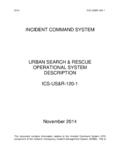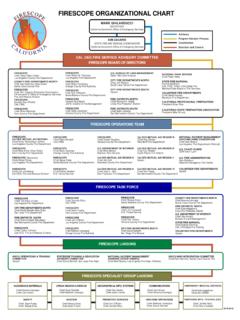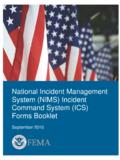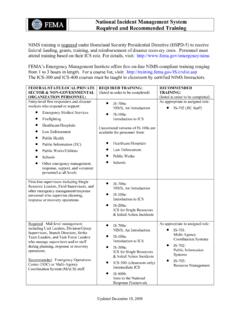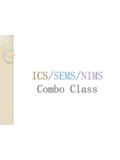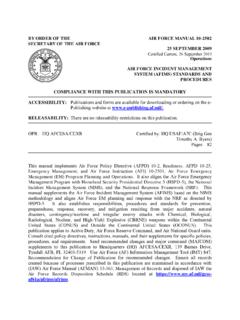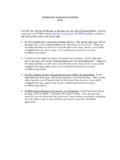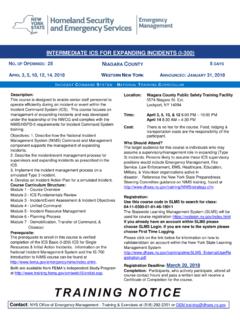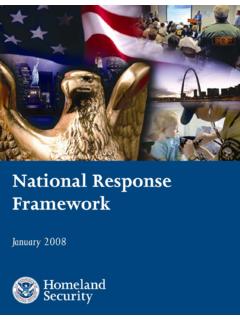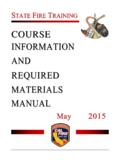Transcription of INCIDENT COMMAND SYSTEM PUBLICATION - …
1 INCIDENT COMMAND SYSTEM PUBLICATION Structure Fire Operations ICS - 500 10 -14 - 2015 1 INCIDENT COMMAND SYSTEM Structure Fire Operations FIrefighting RESources of California Organized for Potential Emergencies This document contains information relative to the INCIDENT COMMAND SYSTEM (ICS) component of the National INCIDENT Management SYSTEM (NIMS). This is the same 2 INCIDENT COMMAND SYSTEM developed by FIRESCOPE. Additional information and documentation can be obtained from the following sources: OES FIRESCOPE OCC 2524 Mulberry Street Riverside, CA 92501-2200 (951) 320-6199 Fax (951) 784-3026 CONTENTS Contents .. 1 Forward .. 3 COMMAND Guidelines .. 5 Responsibilities of COMMAND .
2 5 Functions of COMMAND .. 5 Risk Management .. 6 After Action Review .. 8 Establishing COMMAND .. 8 Initial Radio 8 Radio Designation .. 8 360 Assessment .. 9 Follow-up Radio 9 COMMAND Options .. 9 Passing COMMAND .. 11 Transfer of COMMAND .. 11 General 12 13 Emergency Traffic .. 13 COMMAND 13 INCIDENT COMMAND SYSTEM Organizational Development .. 13 COMMAND Organization .. 14 COMMAND Structure Basic Organization .. 15 Division 17 Division/Group Supervisor 22 COMMAND Structure Expanding the 24 Expanding the Organization Sections .. 25 Expanding the Organization Branches .. 26 Organizational 28 The INCIDENT Commander .. 28 COMMAND Staff .. 29 Single/Unified COMMAND .. 29 Single COMMAND INCIDENT 30 Unified 31 Single/Unified COMMAND 31 3 Appendix A: Glossary of Terms.
3 33 Appendix B: Integrated 38 Appendix C: Sample Tactical Worksheets .. 39 Appendix D: Tactical Priorities and Strategic Objectives .. 46 4 FORWARD FIRESCOPE last revised this document more than twenty years ago. While much of the strategy and tactics of combating structure fires has remained unchanged over the last twenty years, there have been some recent changes that will be recognized in this document. These changes include addressing: Risk Assessment Improved Accountability Rapid Intervention Mayday Transitional Fire Attack It is recognized by FIRESCOPE that the vast majority of structure fires are short term incidents (less than one operational period). Due to the compressed time frame, most structure fire INCIDENT management systems incorporate only the COMMAND and Operations functions of ICS.
4 For longer term incidents requiring the implementation of the Planning, Logistics and/or Finance/Administration functions, the FIRESCOPE Field Operations Guide ICS 420-1 (FOG) should be used as a reference. The purpose of the INCIDENT COMMAND SYSTEM (ICS) is to provide for a systematic development of a complete, functional COMMAND organization designed to allow for single or multi-agency use, which increases the effectiveness of COMMAND and firefighter safety. The National INCIDENT Management SYSTEM (NIMS) identifies concepts and principles that answer how to manage emergencies from preparedness to recovery regardless of their cause, size, location or complexity. The ICS is a component of NIMS. The ICS provides an organized method to apply goals and objectives to structure fire incidents.
5 This SYSTEM helps to provide fire ground safety and accountability. This document is primarily for structural fire incidents but may be applicable to other types of emergency incidents. The key elements of the SYSTEM are: The systematic development of a complete functional organization with the major functions being COMMAND , Operations, Planning, Logistics, and Finance. Designed to allow for multi-agency adoption in federal, state, and local fire agencies. Therefore, organizational terminology used in the ICS is designed to be acceptable to all levels of government. Designed to be the basic, everyday operating SYSTEM for all incidents within each agency. Therefore, the transition to large and/or multi-agency operations requires minimal adjustment for any of the agencies involved.
6 The organization builds from the ground up, with the management of all major functions initially being the responsibility of one or just a few persons. Functional units are designed to handle the most important INCIDENT activities. As the INCIDENT grows in size and/or complexity, 5 functional unit management is assigned to additional individuals in order to maintain a reasonable span of control and efficiency. Designed on the premise that the jurisdictional authority of the involved agencies will not be compromised. Each agency having legal responsibility within its jurisdiction is assumed to have full COMMAND authority within its jurisdiction at all times. Assisting agencies will normally function under the direction of the INCIDENT Commander appointed by the agency having jurisdiction.
7 Multi-jurisdictional incidents will normally be managed under a Unified COMMAND management structure involving a single INCIDENT COMMAND Post and a single INCIDENT Action Plan applicable to all agencies involved in the INCIDENT . The SYSTEM is intended to be staffed and operated by appropriate personnel from any agency, and a typical INCIDENT could involve the use of personnel from a variety of agencies, working in many different parts of the organization. The SYSTEM expands and contracts organizationally based upon the needs of the INCIDENT . Span-of-control recommendations are followed closely; therefore, the organizational structure is not larger than required. Although the focus of this document is structure fire operations, the document recognizes the importance in the fire service of coordinating INCIDENT response with responders of other disciplines, such as medical, law enforcement, and public works.
8 An effective INCIDENT management SYSTEM must provide an integrated multi-discipline approach. The ICS provides an overall structure that allows the successful integration of multiple disciplines, allowing application to the all hazard nature of emergency incidents. The FIRESCOPE Program believes that any INCIDENT management SYSTEM should be guideline driven for the following reasons: Written guidelines reflect department best practices for INCIDENT management. Guidelines provide a standardized approach to managing any INCIDENT . Guidelines provide predictable approaches to INCIDENT management. Guidelines should be applied routinely. Guidelines provide a training tool for firefighter reference. Guidelines provide a baseline for critiques and review of incidents.
9 Guidelines make the INCIDENT Commander s operations more effective. This model reflects a guidelines approach to the overall organization structure of the ICS. 6 COMMAND GUIDELINES Purpose: This document identifies standard operating guidelines that can be employed when establishing COMMAND at a structure fire INCIDENT . The SYSTEM provides for the effective management of personnel and resources while providing for the safety and welfare of personnel. It also establishes guidelines for the implementation of all components of ICS for structure fire operations. COMMAND Guidelines are designed to: Establish the responsibility for COMMAND on a specific individual through a standard identification SYSTEM , depending on the arrival sequence of members, companies, and chief officers.
10 Ensure that formal COMMAND will be established from the onset of the INCIDENT . Establish an effective INCIDENT organization defining the activities and responsibilities assigned to the INCIDENT Commander and to other individuals operating within ICS. Provide a SYSTEM to process information to support INCIDENT safety, accountability, management, planning, and decision making. Provide a SYSTEM for the orderly transfer of COMMAND to subsequent arriving officers. UResponsibilities of CommandU The INCIDENT Commander is responsible for the overall management of the INCIDENT . The safety, welfare and accountability of personnel are taken into consideration when achieving the following INCIDENT priorities: 1. Life safety 2.
